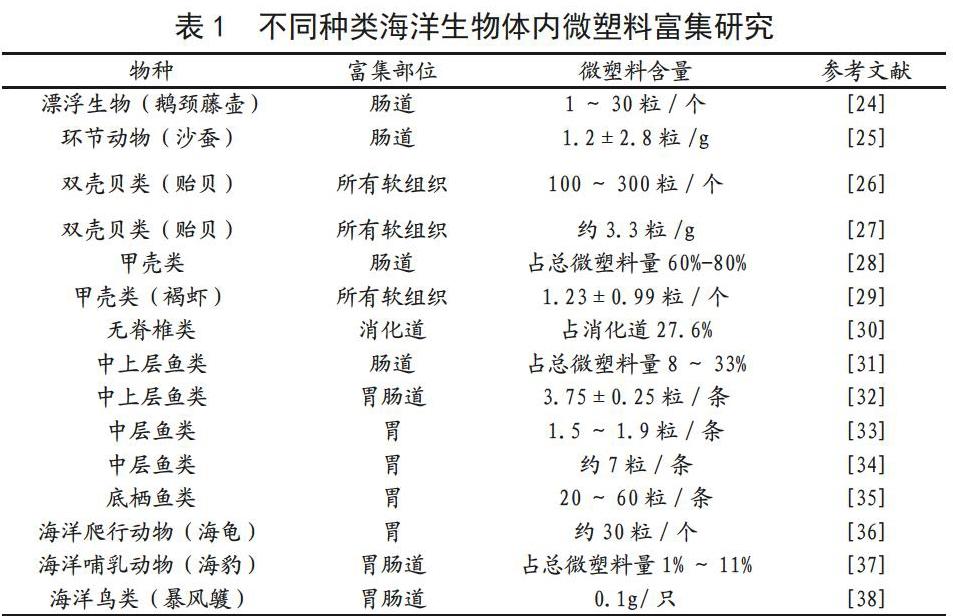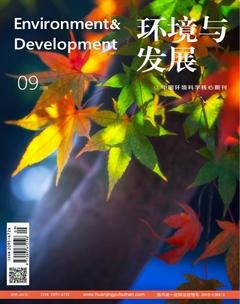微塑料对水生生物的生态毒理效应研究进展
杨秉倬 黄河

摘要:随着塑料的大量生产和使用,由此而产生的塑料污染问题逐渐引起了人们的关注。各种塑料制品被当做废物随意遗弃到环境后,在各种环境因素的作用下会变为塑料微粒,随地表径流进入水环境,最终进入大海,如果不对其进行管理和控制,将贻害无穷。为系统性地了解微塑料对水生生物的影响,本文概述了微塑料在水环境中的环境行为,归纳了微塑料在水生生物中的生物累积及毒性机制,从其对水生动物行为、生长发育、免疫及基因遗传等方面的影响综述了微塑料的生态毒性效应,并概述了微塑料对其他有毒污染物的生态毒理效应的影响。最后,对未来微塑料生态毒理效应的研究方向进行了展望,以期对微塑料的环境危害研究提供更多理论参考。
关键词:微塑料;水生生物;生物累积;毒理效应
中图分类号:X503.22 文献标识码:A 文章编号:2095-672X(2019)09-0-05
DOI:10.16647/j.cnki.cn15-1369/X.2019.09.074
Research progress on the ecotoxicological effects of microplastics on aquatic organisms
Yang Bingzhuo,Huang He
(School of Chemical and Environmental Engineering , Yangtze University,Jingzhou Hubei 434023,China)
Abstract: With the increasing production and use of plastics, the problem of plastic pollution has gradually attracted peoples attention. After being discarded as waste into the environment, plastic products will become particle matter under natural environmental factors, enter the water environment with surface runoff, and eventually enter the sea. If not managed and controlled, the consequences will be endless. In order to understand the effects of microplastics on aquatic organisms systematically, the environmental behavior of microplastics in water environment was outlined, the bioaccumulation and toxicity mechanisms of microplastics in aquatic organisms were generalized, the behavior, growth, immune and genetic aspects of the aquatic animals were reviewed and the combined toxicity of microplastics and other pollutants was summarized in this paper. Finally, the direction of the research on the ecotoxicological effects of microplastics was prospected, so as to provide more theoretical references for the further research on the harmful effects of microplastics in the environment.
Keywords: Microplastics;Aquatic organisms;Bioaccumulation;Toxicological effect
塑料来源广泛,种类繁多,已广泛应用于社会生产以及人类生活的各个方面,与此同时由塑料产生的环境污染问题也逐渐受到了关注。微塑料(Microplastic)这个概念由Tompson于2004年首次提出,并将其定义为粒径小于5mm的塑料粒子[1]。微塑料化学性质稳定、难以降解,可在环境中存在数百年至上千年。环境中的微塑料根据组分可分为聚乙烯(PE) 、聚丙烯(PP)、聚氯乙烯(PVC)、聚酰胺(PA)等[2]。Galgani等人[3]根据粒径大小将微塑料分为小型微塑料(粒径小于1mm)和大型微塑料(粒径在1-5mm之间);根据来源也可将微塑料分为两类:一类是初生微塑料,其成品就是塑料微粒,例如日化用品中含有的微塑料及在运输过程中泄露进入环境的塑料微珠;另一类是次生微塑料,也就是体积较大的塑料垃圾进入自然环境后,经过长时间的物理、化学或生物作用,塑料碎片的结构逐渐被破坏,最终降解后的塑料微粒[4]。
水环境是最易受污染的系统之一,微塑料等多种污染物可通过污水排放、地表径流或大气沉降等最终归于河、湖和海洋中。水体微塑料污染是一个全球范围内的问题,无论是深海水域、淡水环境还是陆地环境中,甚至在赤道[5]和极地[6]研究人员均检测到了它的存在。最新研究发现,人口稀少的马尔代夫Faafu环礁海水中也检测到了平均丰度为0.32±0.15粒/m3的微塑料,该地沉积物中微塑料平均丰度也达到了22.8±10.5粒/m3[7];印度尼西亚被认为是世界上第二大海洋塑料碎片来源地,对其11个海滩站采集的样品进行分析,发现样品中含有多种微塑料,其中包括PP(54.0 ± 13.0%)、PE(17.3 ± 8.3%)、PS(10.4 ± 9.1%)等[8]。为详细了解微塑料的性质和毒性机理,达到保护环境和人类健康的目的,本文概述了微塑料在水环境中的环境行为,歸纳了微塑料在水环境中的生物累积,从其对水生动物行为、生长发育、免疫及基因遗传等方面的影响综述了微塑料的生态毒性效应,并概述了微塑料与其他污染物的联合毒性效应。
1 微塑料在水环境中的行为
根据相关研究可以得知,微塑料在水环境中的行为大致包括迁移、沉降、堆积等物理行为;降解、氧化等化学行为以及摄入、富集等生物行为[9]。首先,风的驱动对微塑料的迁移起着不可忽视的作用,Kukulka等[10]提出对上层海洋塑料含量的准确估计必须考虑到风力的影响,可以说大多数微塑料的迁移都是风作用后的结果。虽然微塑料密度比海水低,但是由于菌落的定植、浮游植物的附着以及有机碎片和金属的聚集等作用,漂浮的塑料碎片最终会沉到海底,甚至有学者[11]认为深海沉积物中很有可能大多是微塑料的沉淀。在堆积方面,在北大西洋等非开放的海域中,由于亚热带洋流及环流运动形成了微塑料的高污染堆积区[12]。可见水体微塑料污染具有长期持久性,一旦形成微塑料堆积,其解决难度比较大,污染比较严重。
塑料碎片的降解主要通过机械侵蚀、光诱导降解和细菌或真菌的生物降解的组合来完成[13]。降解后的微塑料大多数具有脆性、毛边或裂纹等物理特征,降解到一定粒径即会释放在海洋环境中从而对水环境及水生生物的生存与健康造成威胁[14]。不同类型微塑料的降解速度会有所不同,比如PE就比PP更耐化学风化,PE更易降解[15]。综合各方面的资料发现:微塑料正以一种潜移默化的形式对水体环境产生影响,而且当前水环境中微塑料污染范围已极为广泛。
2 微塑料在水生生物中的累积
近些年微塑料研究多关注其采集[16-17]、分离与提取[18-19]及鉴定[20-21],生物累积和食物链迁移研究相对来说还是较少的。通过研究微塑料在生物体内不同器官和组织的富集及转移来探讨微塑料对生物体的毒性效应,对今后科学地评价微塑料的环境风险具有重要意义。
2.1 生物富集部位
微塑料的粒径一般在5 mm以内,容易被海洋环境中的浮游动物、底栖生物、鱼类等误食, 从而危害其生长。例如,Rummel等人[22]从海里捕获的底层鱼类(鳕鱼和比目鱼)和中上层鱼类(鲱鱼和鲭鱼)内检测到粒径大小在200μm-2.2mm之间的PE和PP等微塑料。Alomar等人[23]通过检测地中海附近海域的上百条锯尾鲨发现,其体内富集有5mm左右的PP和PA等塑料。微塑料在不同种类海洋生物体内的富集研究已成为其生态效应研究的热点之一,部分相关研究内容如表1所示。
由表1可以看出:微塑料进入生物体后不能及时被代谢,可以富集在水生动物的胃肠道组织中以及甲壳类和双壳类动物的所有软组织中。不同组织器官中微塑料的富集程度不同,其中胃肠道是主要的富集部位。微塑料富集剂量已经破坏了生态系统的平衡与协调,达到污染水平程度,对生物个体的生理健康造成威胁。
2.2 微塑料的水生食物链迁移
微塑料进入水环境后可能被浮游生物所误食,并通过食物链从低营养级转移到高营养生物体内。Setala等[39]将摄有标记的PS微粒的浮游动物提供给糠虾作为食物,3小时后显微镜下观察到糠虾肠道中存在PS微粒。Mattsson等[40]研究微塑料食物链效应时也选择了PS,他们发现PS被大型溞摄食后能够通过食物链转移到鲤鱼体内并富集,严重影响了鲤鱼的行为和新陈代谢。值得注意的是,微塑料可能已经进入人类的食物链体系。有文献报道,对供人类食用的大西洋鳕鱼进行抽样调查,结果在2.4%的大西洋鳕鱼消化道中检测到了微塑料[41]。
环境迁移和生物放大作用会加剧微塑料的潜在危害,影响人类健康和整个生态系统的协调,所以更深层的研究微塑料环境迁移和生物放大作用迫在眉睫。微塑料随着食物网在更高营养级生物体内具有怎样的生物放大效应及富集效应,以及沿着食物链进入人体后产生怎样的危害还需要进一步研究[42]。
3 微塑料對水生生物的毒性效应
微塑料被小型动物甚至一些稍大型动物误食后无法被消化, 可能堵塞肠道,产生长时间的虚假饱腹感,影响正常的食物摄取,体内能量储备减少[43],机体生长所需能量来源补充不足[44],最终导致生物体的饥饿和死亡[45]。微塑料进入生物体内产生的一系列生态毒理学效应可以概括为六个方面:行为毒性、生长发育毒性、致死效应、生殖毒性、免疫毒性和基因与遗传毒性。
3.1 行为毒性
微塑料在短时间内低浓度下的暴露不会使生物体致死,但会影响其行为活动。Chen等[46]观察到微塑料可以改变斑马鱼幼鱼的游动行为,这是微塑料使斑马鱼zfrho视觉基因表达出现上调的结果。微塑料的暴露还会严重扰乱生物体的摄食行为:PS的存在能够降低紫贻贝的滤食效率[47];欧洲鲈鱼暴露在一定浓度的90μm PS颗粒的环境下,孵化会被抑制,生长速度降低,捕食能力和逃避天敌的先天行为也发生了明显改变[48]。
3.2 生长发育毒性
微塑料会影响生物体的正常生长发育。在急性暴露条件下,橙线雀幼鱼的生长速度随2mm粒径的PET浓度的升高而降低[49]。经 10~45 μm PE暴露5 d后,超过30%的海胆幼虫的胃内检测到了微塑料,并发现摄入的微塑料越多海胆的体形变得越小,体重越轻[50]。原生微塑料对胚胎发育具有毒性作用,研究表明,与空白对照组相比微塑料的暴露使海胆胚胎的异常发育率从52.0%增加至84.6%[51]。
3.3 致死效应
微塑料的暴露最终可导致生物体存活率下降。Au等[52]的试验发现:端足类美洲钩虾暴露在PE和PP中显示出明显的剂量-效应关系,随着微塑料暴露剂量的上升,钩虾的死亡率也呈现出逐渐升高的趋势。Mazurais等[53]发现欧洲鲈鱼幼鱼在粒径为10~45μm PE暴露下,随暴露剂量的增加其死亡率从30%增加至44%。
3.4 生殖毒性
微塑料可导致水生生物胚胎发育受阻、孵化率下降、发育畸形等。Sussarellu等[54]将牡蛎暴露于2μm和6μm的PS颗粒环境两个月后发现,与对照组相比,PS使牡蛎产生卵细胞的数量和大小、精子的运动速度等指标均有所降低,该研究表明PS微塑料颗粒会干扰牡蛎的摄食和繁殖,影响产卵量和后代幼体的发育。
3.5 免疫毒性
微塑料还会产生免疫毒性。比如,粒径小于 80μm 的HDPE可在贻贝消化系统中富集,出现血流粒细胞增多和溶酶体膜不稳定等现象,引发机体免疫系统的炎症反应[55]。Pedà等[56]利用组织病理学分析了PVC碎片暴露对欧洲鲈鱼的影响,研究结果表明,PVC的暴露会引起鲈鱼肠道末端明显的炎症反应,且随着暴露时间的增加,肠道末端的病变程度呈现出由中度逐渐到重度的趋势。
3.6 基因与遗传毒性
从细胞和基因角度看,微塑料具有一定的毒性作用。比如,经过两个月的慢性饮食暴露后,青鳉鱼出现内分泌功能受损和Chg H、Vtg I基因表达明显下调的现象,且精原细胞和精母细胞异常增殖,其遗传信息的表达受到影响[57]。还有研究发现PS微塑料会导致紫贻贝上千个基因表达出现异常以及增加突变可能[58]。
4 微塑料与其他物质复合作用下的生态毒理效应
由于微塑料具有比表面积大、疏水性强等特点,使其具有富集持久性有机污染物和重金属的能力,成为污染物的载体。微塑料类型、粒径大小、暴露剂量等因素同样是影响复合作用的重要因素,此外不同配比方式、作用对象、观察指标等因素也会导致不同的联合作用结果。进入生物体后,微塑料所吸附的污染物可能随之释放出来,释放之后的复合作用大多是相加或协同作用。Teuten等[59]实验证明,向含有菲的沉积物中分别加入PE、PP、PVC这三种微塑料均可显著提高海蚯蚓组织中菲的浓度,从而增强了毒性作用。Karami等人[60]进一步探讨了LDPE与菲联合作用的毒性机制,暴露96h后发现LDPE改变了菲对非洲鲶鱼幼鱼肝组织的变化程度、总蛋白含量、血浆胆固醇浓度和肝糖原的转录水平的影响程度。Oliveira等人[61]采用1-5μm PE微球和多环芳烃芘研究其对鰕虎鱼幼鱼的生理影响,试验发现PE增加了鱼胆汁中芘代谢物的浓度,并且二者混合物显著降低了鰕虎鱼的乙酰胆碱酯酶 (AChE)和异柠檬酸脱氢酶(IDH)的活性, 从而可能会增加天然鱼类种群的死亡率。此外,有学者利用组织学观察到日本青鳉鱼摄食结合有多环芳烃、多氯联苯和多溴联苯醚的PE颗粒后,吸附污染物出现了转移,引起青鳉鱼诱发肝脏应激,出现肝糖原耗竭、脂肪空泡化、细胞坏死和病变等现象[62]。目前微塑料和其他物质的拮抗作用尚未有文献报道,综上所述,微塑料对水体环境及生物的损害只注重其本身的研究是片面的,吸附有毒污染物的塑料微粒的生态效应影响更大。
5 研究展望
进入水环境的微塑料通过迁移和富集后,最终以自身毒性以及吸附重金属或持久性有机物等化学物质造成永久性的危害。而微塑料危害程度与其本身粒径大小、暴露剂量、表面污染情况、暴露时间以及生物体性质等呈显著相关性。基于此,对于未来开展微塑料对水生生物的生态毒理效应研究提出以下见解:
(1)微塑料对水生生物的毒害是一个复杂且漫长的过程,微塑料与重金属或持久性有机物等其他化学污染物的联合毒害作用更是复杂。然而现有的研究均局限于短期的、暴露浓度比实际环境浓度高出几个数量级的室内实验条件,这有悖于现实意义。在未来的研究中,真实环境条件下不同种类和粒径的微塑料与其他污染物质的长期混合作用及其毒理机制仍然是需要攻克的重要内容。同时,提升微塑料源解析技术和实现塑料降解速度的一定程度的调控,有利于微塑料污染的源头控制。
(2)微塑料粒径小、比表面积大、疏水性强的特性使其往往吸附并富集其他物质,研究微塑料生态效应时应注重微塑料与有毒物质的多重作用,尽管Razanajatovo等人[63]采用PE对磺胺甲恶唑、丙泊酚和舍曲林在水中的吸附解析性能进行了研究并得到相关吸附率顺次,但微塑料的吸附能力、吸附过程、吸附行为等吸附及解吸机理研究仍存在很大的研究空白。
(3)至今關于微塑料对生物 LC50值研究报道甚少,为了进一步研究并预测生物体对环境中微塑料的响应和变化,应开展急性毒理试验、亚急性毒理试验、慢性毒理试验的综合研究,分析建立生物体(考虑多个生命阶段)随时间变化而产生的各种病变的数据库,通过对低营养级生物到高营养级生物的食物链效应研究来探索微塑料最终对人类构成的威胁程度,为微塑料的生态毒理效应研究及风险评估提供更多依据。
参考文献
[1]Thompson R C, Olsen Y, Mitchell R P, et al. Lost at sea: where is all the plastic ? [J].Science,2004,304(5672):838.
[2]Vandermeersch G, Van Cauwenberghe L, Janssen C R, et al. A critical view on microplastic quantification in aquatic organisms[J].Environmental Research, 2015,143:46-55.
[3]Galgani F, Hanke G, Werner S, et al. Marine litter within the European Marine Strategy Framework Directive[J].ICES Journal of Marine Science,2013, 70(06):1055-1064.
[4]Syberg K, Khan F R, Selck H, et al. Microplastics: addressing ecological risk through lessons learned[J].Environmental Toxicology and Chemistry, 2015,34(05):945-953.
[5]Ivar d S J A , Costa M F , Barletta, Mário, et al. Pelagic microplastics around an archipelago of the Equatorial Atlantic[J]. Marine Pollution Bulletin, 2013, 75(1-2):305-309.
[6]Obbard R W, Sadri S, Wong Y Q, et al. Global warming releases microplastic legacy frozen in Arctic Sea ice[J]. Earths Future,2014, 2(06):315-320.
[7]Saliu F, Montano S, Garavaglia M G, et al. Microplastic and charred microplastic in the Faafu Atoll,Maldives[J].Marine Pollution Bulletin, 2018,136:464-471.
[8]Syakti A D, Hidayati N V, Jaya Y V, et al. Simultaneous grading of microplastic size sampling in the Small Islands of Bintan water, Indonesia[J].Marine Pollution Bulletin,2018,137:593-600.
[9]Wang J D, Tan Z, Peng J P, et al. The behaviors of microplastics in the marine environment[J]. Marine Environmental Research, 2016, 113:7-17.
[10]Kukulka T, Proskurowski G S. Morét-Ferguson, et al. The effect of wind mixing on the vertical distribution of buoyant plastic debris[J]. Geophysical Research Letters, 2012, 39(07):7601.
[11]Woodall L C, Sanchez-Vidal A, Canals M, et al. The deep sea is a major sink for microplastic debris[J]. Royal Society Open Science, 2014, 1(04):140317.
[12]Law K L, Moret-Ferguson S, Maximenko N A,et al. Plastic Accumulation in the North Atlantic Subtropical Gyre[J].Science, 2010, 329(5996):1185-1188.
[13]Moore C J. Synthetic polymers in the marine environment: A rapidly increasing, long-term threat[J].Environmental Research, 2008,108(02):131–139.
[14]Roy P K, Hakkarainen M, Varma I K, et al. Degradable polyethylene:fantasy or reality[J].Environmental Science& Technology. 2011,45(10):4217-4227.
[15]Zbyszewski M, Corcoran P L. Distribution and Degradation of Fresh Water Plastic Particles Along the Beaches of Lake Huron, Canada[J]. Water Air and Soil Pollution,2011, 220(1-4):365-372.
[16]Nuelle M T, Dekiff J H, Remy D, Fries,E.A new analytical approach for monitoring microplastics in marine sediments[J]. Environmental Pollution, 2014,184(01): 161–169.
[17]Green D S, Kregting L, Boots B, et al. A comparison of sampling methods for seawater microplastics and a first report of the microplastic litter in coastal waters of Ascension and Falkland Islands[J].Marine Pollution Bulletin,2018,137:695-701.
[18]Wenfeng W, Jun W. Investigation of microplastics in aquatic environments: An overview of the methods used, from field sampling to laboratory analysis[J],Trends in Analytical Chemistry,2018,8:1-33.
[19]Wagner J, Wang Z, Ghosal S, et al. Novel method for the extraction and identification of microplastics in ocean trawl and fish gut matrices [J].Anal Methods-UK,2017,9(09): 1479-1490.
[33]Digka N, Tsangaris C, Torre M, et al. Microplastics in mussels and fish from the Northen Ionian Sea[J].Marine Pollution Bulletin,2018,135:30-40.
[34]Romeo T, Pietro B, Pedà C, et al. First evidence of presence of plastic debris in stomach of large pelagic fish in the Mediterranean Sea[J]. Marine Pollution Bulletin, 2015, 95(01):358-361.
[35]Ramos J A A. Barletta M, Costa Monica F. Ingestion of nylon threads by Gerreidae while using a tropical estuary as foraging grounds[J]. Aquatic Biology, 2012,17(01):29-34.
[36]Tourinho P S, Sul J A I D, Fillmann G.Is marine debris ingestion still a problem for the coastal marine biota of southern Brazil? [J].Marine Pollution Bulletin,2010,60(03):396-401.
[37]Rebolledo E L B, Van Franeker J A, Jansen O E, et al. Plastic ingestion by harbour seals(Phoca vitulina)in The Netherlands[J].Marine Pollution Bulletin,2013,67(1/2):200-202.
[38]Franeker J A V, Blaize C, Danielsen J, et al. Monitoring plastic ingestion by the northern fulmar Fulmarus glacialis in the North Sea[J].Environmental Pollution,2011, 159(10):2609-2615.
[39]Setala O, Fleming-lehtinen V, Lehtiniemi M. Ingestion and transfer of microplastics in the planktonic food web[J].Environmental Pollution, 2014, 185: 77-83.
[40]Mattsson K, Ekvall M T, Hansson L A, et al. Altered Behavior, Physiology, and Metabolism in Fish Exposed to Polystyrene Nanoparticles[J].Environmental Science&Technology,2015, 49(01):553-561.
[41]Liboiron M, Liboiron F, Wells E, et al. Low plastic ingestion rate in Atlantic cod(Gadus morhua)from Newfoundland destined for human consumption collected through citizen science methods[J].Marine Pollution Bulletin,2016,113(1-2):428-437.
[42]Lusher A L, Mchugh M, Thompson R C. Occurrence of microplastics in the gastrointestinal tract of pelagic and demersal fish from the English Channel[J]. Marine Pollution Bulletin, 2013, 67(1-2):94-99.
[43]Watts A J, Lewis C, Goodhead R M, et al. Uptake and retention of microplastics by the shore crab Carcinus maenas[J].Environmental Science&Technology,2014,48(15):8823-8830.
[44]José G B Derraik.The Pollution of the Marine Environment by Plastic Debris:A Review[J].Marine Pollution Bulletin,2002,44(09):842-852.
[45]Lee K W, Shim W J, Kwon O Y, et al. Size-dependent effects of micro polystyrene particles in the marine copepod Tigriopus japonicas [J]. Environmental Science and Technology,2013,47(19): 11278-11283.
[46]Chen Q, Gundlach M, Yang S, et al. Quantitative investigation of the mechanisms of microplastics and nanoplastics toward zebrafish larvae locomotor activity[J]. Science of The Total Environment, 2017,584-585:1022-1031.
[47]Wegner A, Besseling E, Foekema E M, et al. Effects of nanopolystyrene on the feeding behavior of the blue mussel (Mytilus edulis L.)[J]. Environmental Toxicology & Chemistry, 2012,31(11):2490-2497.
[48]Lonnstedt O M, Eklov P. Environmentally relevant concentrations of microplastic particles influence larval fish ecology[J]. Science, 2016, 352(6290):1213-1216.
[49]Critchell K, Hoogenboom M O, Patterson H M, et al. Effects of microplastic exposure on the body condition and behaviour of planktivorous reef fish (Acanthochromis polyacanthus)[J]. Plos One, 2018, 102(102):178-190.
[50]Kaposi K L, Mos B, Kelaher B P, et al. Ingestion of microplastic has limited impact on a marine larva[J].Environmental Science and Technology, 2014,48(3):1638-1645.
[51]Nobre C R, Santana M F M, Maluf A, et al. Assessment of microplastic toxicity to embryonic development of the sea urchin Lytechinus variegatus (Echinodermata: Echinoidea) [J].Marine Pollution Bulletin, 2015, 92(1-2): 99-104.
[52]Au S Y, Bruce T F, Bridges W C, et al. Responses of Hyalella azteca to acute and chronic microplastic exposures[J]. Environmental Toxicology and Chemistry, 2015, 34(11):2564-2572.
[53]Mazurais D, Ernande B, Quazuguel P, et al. Evaluation of the impact of polyethylene microbeads ingestion in European sea bass (Dicentrarchus labrax) larvae[J].Marine Environmental Research, 2015, 112:78-85.
[54]Sussarellu R, Suquet M, Thomas Y, et al. Oyster reproduction is affected by exposure to polystyrene microplastics[J].Proceedings of the National Academy of Sciences,2016,113(09):2430-2435.
[55]Moos N V, Burkhardt-Holm P, Angela K?hler. Uptake and Effects of Microplastics on Cells and Tissue of the Blue Mussel Mytilus edulis L after an Experimental Exposure[J]. Environmental Science & Technology, 2012, 46(20):11327-11335.
[56]Pedà C, Caccamo L, Fossi M C, et al. Intestinal alterations in European sea bass Dicentrarchus labrax (Linnaeus,1758) exposed to microplastics: Preliminary results[J].Environmental Pollution,2016, 212:251-256.
[57]Rochman C M, Kurobe T, Flores I, et al. Early warning signs of endocrine disruption in adult fish from the ingestion of polyethylene with and without sorbed chemical pollutants from the marine environment[J].Science of The Total Environment,2014, 493:656-661.
[58]Browne M A, Dissanayake A, Galloway T S, et al. Ingested Microscopic Plastic Translocates to the Circulatory System of the Mussel, Mytilus edulis(L.)[J].Environmental Science and Technology, 2008, 42(13):5026-5031.
[59]Teuten E L, Rowland S J, Galloway T S, et al. Potential for Plastics to Transport Hydrophobic Contaminants[J].Environmental Science & Technology, 2007, 41(22):7759-7764.
[60]Karami A, Romano N, Galloway T, et al.Virgin microplastics cause toxicity and modulate the impacts of phenanthrene on biomarker responses in African catfish (Clarias gariepinus)[J].Environmental research,2016,151:58-70.
[61]Oliveira M, Ribeiro A, Hylland K, et al. Single and combined effects of microplastics and pyrene on juveniles(0+group) of the common goby Pomatoschistus microps(Teleostei,Gobiidae)[J].Ecological Indicators,2013,34:641-647.
[62]Rochman C M, Hoh E, Kurobe T, et al. Ingested plastic transfers hazardous chemicals to fish and induces hepatic stress[J]. Scientific Reports, 2013, 47(03):1646-1654
[63]Razanajatovo R M, Ding J, Zhang S, et al. Sorption and desorption of selected pharmaceuticals by polyethylene microplastics[J].Marine Pollution Bulletin,2018,136:516-523.
收稿日期:2019-08-19
基金項目:湖北省新农村发展研究院(长江大学)开放基金
作者简介:杨秉倬(1994-),女,硕士研究生,研究方向为生态毒理学。
通讯作者:黄河,男,副教授,研究方向为污染物在环境中的环境行为和毒性效应。

